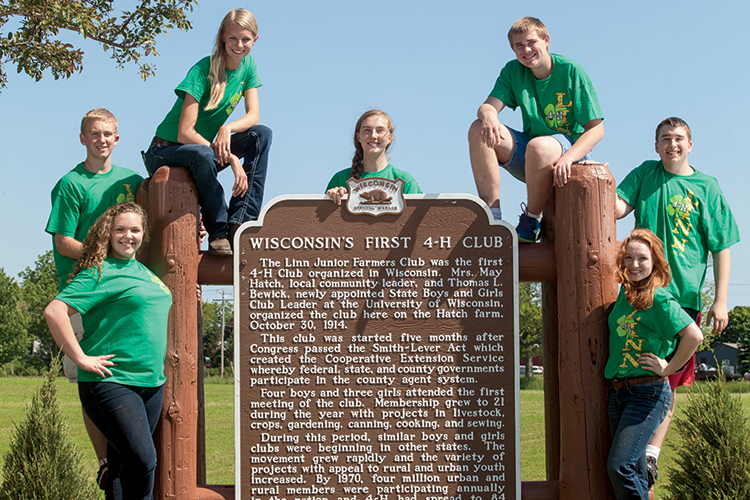Home > Wisconsin > Wisconsin Ag Education > 100 Years of Wisconsin 4-H
100 Years of Wisconsin 4-H
In partnership with: Wisconsin Department of Agriculture, Trade and Consumer Protection.

Ask any 4-H local leader across Wisconsin and they’ll tell you – they do it for the kids. “It’s really great to see kids grow and become leaders in fields they pursue. 4-H kids are very special,” says Donna Kundert, one of four leaders of the Linn 4-H Club – the oldest in the state. The national organization is celebrating 100 years in the Badger State in 2014, recognizing a century of accomplishments with events throughout the year.
4-H Is Born
The 4-H idea can trace its heritage back to the turn of the 20th century, but the national 4-H club was created by Congress in 1914 when it passed the Smith-Lever Act establishing the Extension Service. Five months later, in October 1914, the 4-H program took root in Wisconsin with the Linn Club in Walworth County, then called the Linn Junior Farmers. Though the program has progressed over the past century, its core goals are the same. With members ranging from ages 5 to 19, the 4-H experience is designed to address critical elements of positive youth development, such as belonging, mastery, generosity and independence with an emphasis on learning through hands-on experiences.
“We try to prepare youth for successful careers and futures,” says Jackie Askins, public information specialist for Wisconsin 4-H. “The program has definitely grown with the agriculture industry. It started with corn growing and canning clubs that prepared them for ag careers of the time, and now we focus more on science, technology, engineering, communications and more, plus skills like leadership and critical thinking.”
Today, about 50,000 Wisconsin youth are enrolled in the state’s 4-H clubs, with another 195,000 participating through special educational opportunities at school, after-school programs and neighborhood youth centers.
Kundert, her husband, Daniel, and two others, Sandy Pillman and Lisa Lasch are now what 4-H calls general leaders, guiding the inaugural Linn Chapter into its next century. Kundert says the most rewarding aspect is seeing how their young 4-H’ers have grown over the years. “The greatest accomplishments for the chapter are the accomplishments of our members,” she says. “We have a very strong group of officers for the 100- year anniversary, and it’s been great to see all the kids growing into their own from a few years back, when we had a lot of younger members.”
Linn Carries the Legacy
Community support has been a key to the chapter’s success over the past century. The Linn Club still meets in the same town hall that it did 100 years ago. As the oldest 4-H chapter in the state, Kundert says members are celebrating the centennial by hosting a public ice cream social to thank the community for that support and they will create a time capsule to be opened during the 150th anniversary celebration.
The Linn 4-H Club regularly contributes to the community by putting on the horse show at the fair every year, displaying educational signs around the arena that explain what the show is about, outlining the criteria of horse showing and judging. Kundert hopes they will expand this project to other areas of the fair, such as the swine barn.
State spokesperson Askins says the Wisconsin 4-H program is one of the four key areas of the University of Wisconsin Extension, so faculty and staff are involved in several anniversary events.
“We kicked off the year-long celebration in March with a rally in Madison at the state capital, and had close to 900 members talking to legislators and sharing with them the positive impact 4-H has on the community,” says Askins. They hosted a 4-H day at the 2014 Wisconsin State Fair with more programs and education booths for all ages.
The Next 100 Years
As for the future of the program, Askins says the goal nationwide is to have one million new scientists and Wisconsin plans to contribute. “The United States is falling behind competitively in the science arena, so 4-H will continue to give youth an early hands-on environment to connect with community members in those careers and fields of study,” she says.
Kundert adds that all local leaders, including herself, are just trying to keep up with the kids and keep them going. “A lot of them need something to ground them, and we’re very proud of what 4-H has to offer.”




![Wisconsin 4-H [INFOGRAPHIC]](https://eadn-wc01-4177395.nxedge.io/wp-content/uploads/2020/05/Screen-Shot-2014-10-21-at-4.31.48-PM.png)
does anyone remember the name of the 4-H club in Bowler, WI in the ’50’s and ’60’s?